617 Search Results for tell me about it
April 20, 2020
by Carole Zangari -

It’s almost Earth Day, and whether you are sheltering in place or still able to be out in the community, there are ways we can all celebrate Earth Day. Here are some suggestions for incorporating AAC as you do. Getting to the Core of Earth Day Let’s Read Let’s Create Let’s Go Outside! Create a language experience survey. Here are some possible questions for your survey What are your favorite outdoor activities? Tell me about a time when you had an outdoor adventure. What are some ways that you reuse and recycle? Tour the Grand Canyon with Elmo & friends. Pay a virtual visit to a national park. Explore some of the Junior Ranger virtual activities. Plan to take some mindfulness moments with trees as suggested by the Heritage Conservancy Build a backyard fairy house. Play backyard conservation Bingo. Go on a nature scavenger hunt using this form from the Delaware... [Read More...]
April 17, 2020
by Carole Zangari -
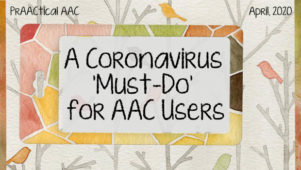
Twelve years ago, when Robin and I first wrote about preparing AAC users for medical emergencies, a pandemic wasn’t on the radar. We were thinking about ‘regular’ things that go wrong, like broken bones and asthma attacks, not a worldwide emergency. Still, some of the helpful tools that we suggested back then remain very helpful and today we are revisiting them. There are a lot of unknowns about Covid-19, but one thing we do know is that when someone is affected, things can change very quickly. The time to plan for the unexpected and unimaginable is now. Please do whatever you need to so that the AAC users in your lives have a communication passport or other document that can help unfamiliar partners understand them and communicate with them. Accept that there may be a situation in which the AAC user is separated from familiar people. AAC users may be... [Read More...]
April 16, 2020
by Carole Zangari -
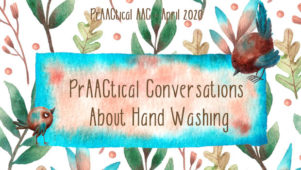
The other day, a friend posted something on social media that many of us can relate to. “Between all the hand sanitizer and cleaning solution that my skin absorbs,” she said, “I’m probably disinfecting the toilet with every trip to the bathroom!” While that’s a bit of a stretch, it is true that most of us are washing our hands more often now than ever before. And for good reason. But some of our AAC learners don’t really like hand washing and it can be a struggle to have them do that several times a day. In today’s post, we share some ideas that can help keep those hands clean. Not everyone will need every strategy, but we included several ideas so that you can select those that are most beneficial for the AAC learners in your life. Teach the skill and use a visual schedule to illustrate the steps.... [Read More...]
April 9, 2020
by Carole Zangari -
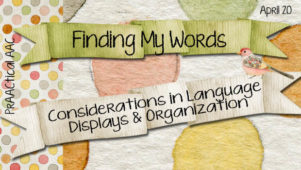
How do you decide which AAC app or software best meets the needs of an individual with complex communication needs? We’re so pleased that longtime contributor Vicki Clarke is back with us to address this topic in a very prAACtical way. Vicki is a Georgia-based SLP who has been specializing in AAC for over 25 years. Her practice, Dynamic Therapy Associates, serves children and adults with significant communication challenges in clinical and educational settings. You can read previous posts by Vicki here. In this post, Vicki dives deep into an important aspect of AAC displays: vocabulary organization. :::::::::::::::::::::::::::::::::::::::::::::::::::::::::::::::::: Finding My Words: Considerations in Language Displays and Organization In previous articles we’ve talked about how easy it is to buy into the very first communication system you learn to use with your students. Maybe you started with LAMP and you have fully embraced a core word strategy. Perhaps you were a... [Read More...]
March 26, 2020
by Carole Zangari -
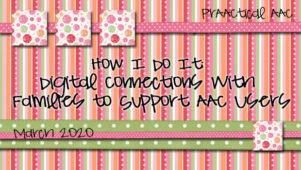
Staying connected with families is such an important aspect of being an effective AAC interventionist. In today’s post, we have a return visit from SLP Sarah Gregory, who shares the things that she is doing to maintain these connections as we learn to do this work from afar. You can read Sarah’s previous contribution here. Digital Connections With Families to Support AAC Users I hope this blog post finds everyone well! The COVID-19 virus has created an uncertain and unprecedented time for us all, but I have gotten so much comfort from the generosity and resource sharing in our AAC SLP community this week. As we get creative in supporting our AAC users remotely, the app SeeSaw has been a key to connecting with my students and families (I am not affiliated with this app in any way). I have used this free app to create a loop between home... [Read More...]
March 16, 2020
by Carole Zangari -
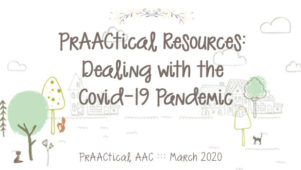
No matter where you live, chances are good that the coronavirus has been on your mind. In today’s post, we share an interactive graphic with many free downloadable resources that can be used to support the AAC learners in your life. You can access visual schedules for handwashing, social narratives, videos, educational materials, and more by clicking the links embedded in the graphic below. Use the slider on the right to navigate up and down, or click the image to go to the full-sized version. This is an evolving resource that will continue to be updated. If you know of things that we should add, please tell us in the comments below. Stay safe and healthy, AAC friends.
March 12, 2020
by Carole Zangari -
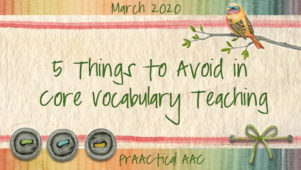
There’s no doubt that core vocabulary plays an important role for the majority of people with AAC needs. When using and teaching them, however, there are some common pitfalls. Here are some thoughts on avoiding them. Don’t equate high-frequency words with ‘first words.’ There is some overlap in core vocabulary and an initial lexicon but they are different things. Both are important. Don’t assume that just because someone has a significant intellectual disability that core vocabulary is irrelevant or too difficult. Many, many people with complex communication needs who have significant cognitive impairments have been successful in learning to use these words. Don’t limit the AAC learner to only core words. If we exclude words that are of great interest or highly motivating, we take the fun out of communication. Don’t get stuck with just the root word. Instead, use various forms of the word (e.g., go, goes, going; big,... [Read More...]
February 20, 2020
by Carole Zangari -
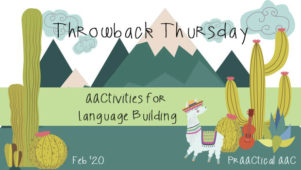
Expanding vocabulary Increasing sentence length and complexity Using a greater range of communicative functions Applying morphological markers Given the heterogeneity of our AAC learners, it’s no surprise that the language goals we address are just as diverse. Today, we dig through the archives to highlight activities that can be used to target an array of language learning objectives. Browse through the list to see if you can find some that are of use in your AAC work. Magic Moments with Tellagami New Word Teaching: A Look Inside Some PrAACtical Therapy Sessions Teaming Up to Build Communication with a Treat Cart: Part 1, Part 2 AACtual Therapy: Use Your Best Spud to Teach Vocabulary With Tanna Neufeld PrAACtical Supports for AAC Learners: AT Recipes for Success – Sensorimotor Activities AAC Intervention: 5 Activities with PrAACtical Potential Vocabulary Activities: 5 Sites for Learning with Avatars PrAACtical Teaching in the Autism Classroom: Instructional... [Read More...]
February 13, 2020
by Carole Zangari -
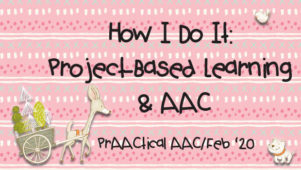
Looking for ways to promote inclusive practices in your school? Today, AAC SLP and AT Consultant Sarah Gregory returns to share more about the strategies and approaches she uses in the peer support program in her school district in Ithaca, NY. Learn about how she implements problem-based learning to promote authentic learning experiences and meaningful connections between students with and without disabilities. You can see Sarah’s previous post on peer modeling here. Project-Based Learning and AAC I discussed in my first blog post the importance of authentic inclusion of students with Complex Communication Needs in the general education classroom. Involving peers in using AAC has been a great tool to move to a model of true inclusion. When incorporating peer support into a classroom structure I am thoughtful to make the interaction authentic and meaningful for everyone involved. Since starting a peer support program two years ago I have continuously... [Read More...]
February 3, 2020
by Carole Zangari -
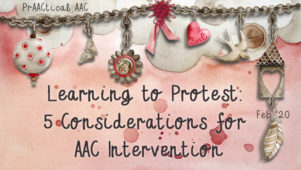
Stop it. No, thank you. Don’t do that. I don’t want ___. Not now. In order to be able to express what they are really thinking, AAC learners need the vocabulary and skills to be able to tell us when they don’t like something or when they do not want to participate. Here are some thoughts about facilitating their growth in this area. Review the vocabulary and messages that are available to the learner. Consider single words (e.g., no, not, stop) and contractions (e.g., don’t, can’t, won’t, shouldn’t), as well as prestored messages that will make it faster and easier to express themselves under stressful conditions when the need for protesting is most important (e.g., I don’t want to. I want you to stop. Don’t make me to that.). Model negation in various contexts. Narrate your own experiences throughout the day (e.g., I don’t want to eat that. Stop touching... [Read More...]









